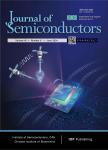FDTD technique based crosstalk analysis of bundled SWCNT interconnects
FDTD technique based crosstalk analysis of bundled SWCNT interconnects作者机构:Department of Electronics and Instrumentation EngineeringMahatma Jyotiba Phule Rohilkhand University Department of Electronics and Communication EngineeringIndian Institute of Technology Shobhit University
出 版 物:《Journal of Semiconductors》 (半导体学报(英文版))
年 卷 期:2015年第36卷第5期
页 面:90-98页
核心收录:
学科分类:080903[工学-微电子学与固体电子学] 0808[工学-电气工程] 0809[工学-电子科学与技术(可授工学、理学学位)] 08[工学] 0805[工学-材料科学与工程(可授工学、理学学位)] 0703[理学-化学] 0702[理学-物理学]
主 题:FDTD SWCNT bundle interconnects crosstalk delay peak voltage coupled transmission lines
摘 要:The equivalent electrical circuit model of a bundled single-walled carbon nanotube based distributed RLC interconnects is employed for the crosstalk analysis. The accurate time domain analysis and crosstalk effect in the VLSI interconnect has emerged as an essential design criteria. This paper presents a brief description of the numerical method based finite difference time domain (FDTD) technique that is intended for estimation of voltages and currents on coupled transmission lines. For the FDTD implementation, the stability of the proposed model is strictly restricted by the Courant condition. This method is used for the estimation of crosstalk induced propagation delay and peak voltage in lossy RLC interconnects. Both functional and dynamic crosstalk effects are analyzed in the coupled transmission line. The effect of line resistance on crosstalk induced delay, and peak voltage under dynamic and functional crosstalk is also evaluated. The FDTD analysis and the SPICE simulations are carried out at 32 nm technology node for the global interconnects. It is observed that the analytical results obtained using the FDTD technique are in good agreement with the SPICE simulation results. The crosstalk induced delay, propagation delay, and peak voltage obtained using the FDTD technique shows average errors of 4.9%, 3.4% and 0.46%, respectively, in comparison to SPICE.



